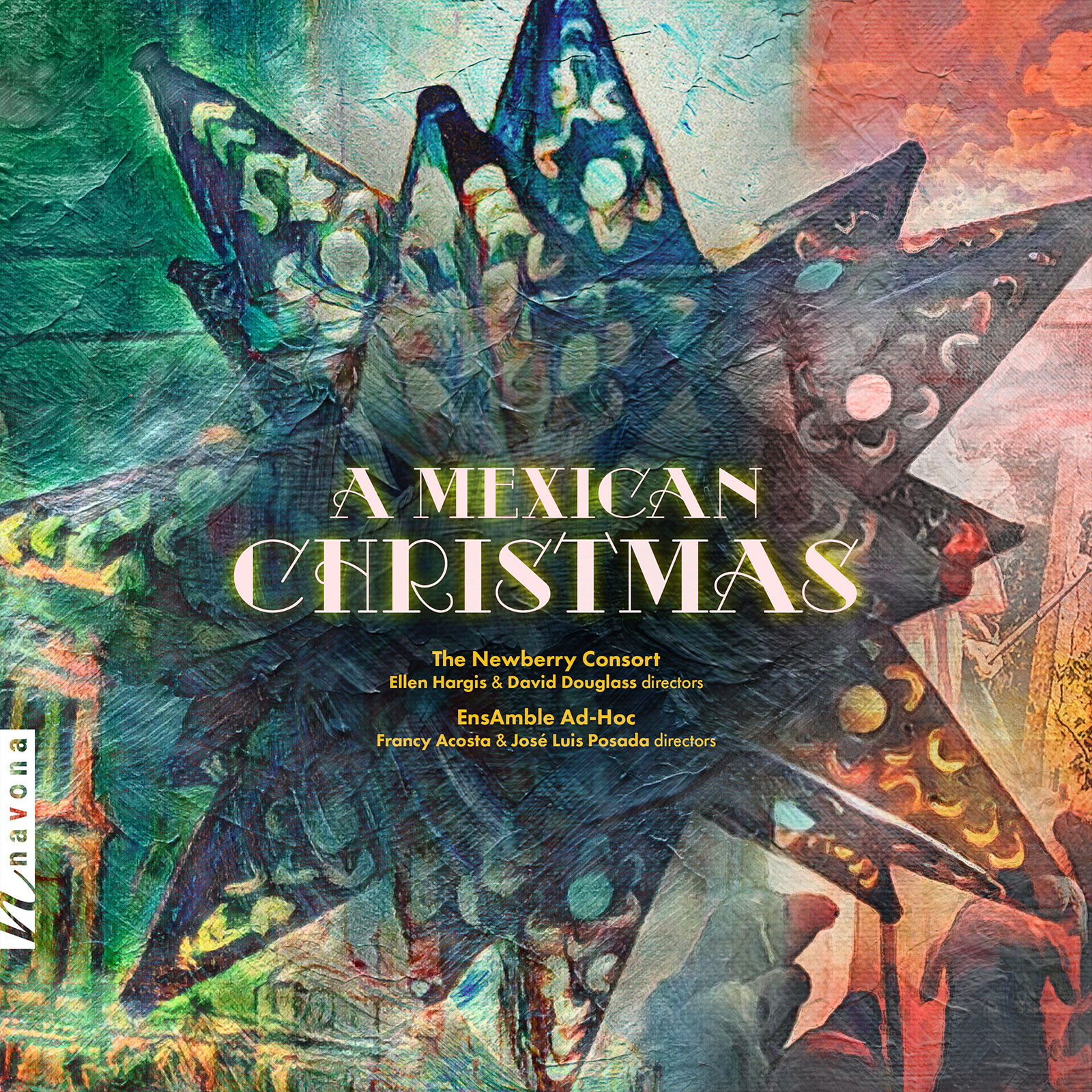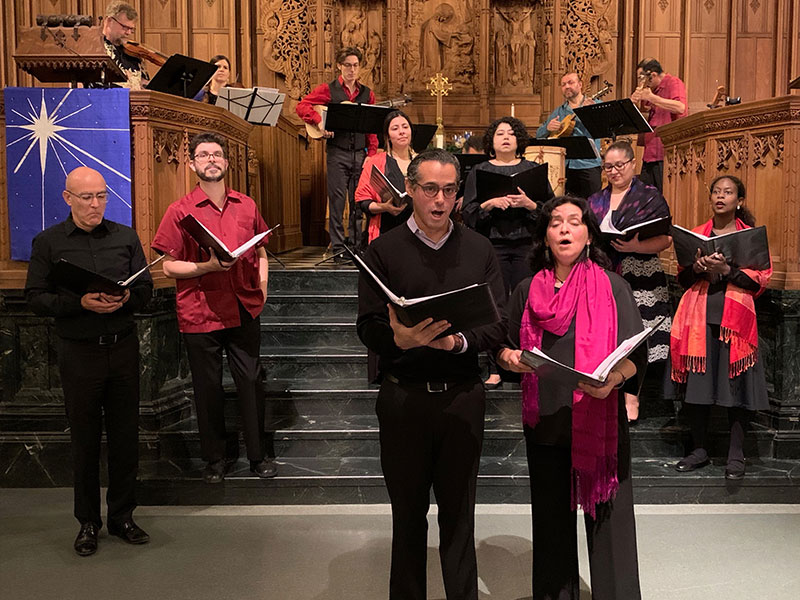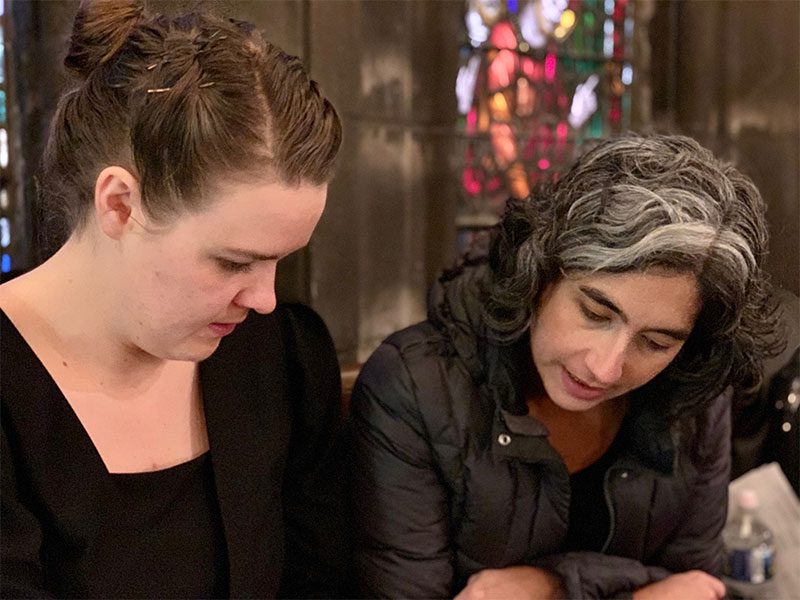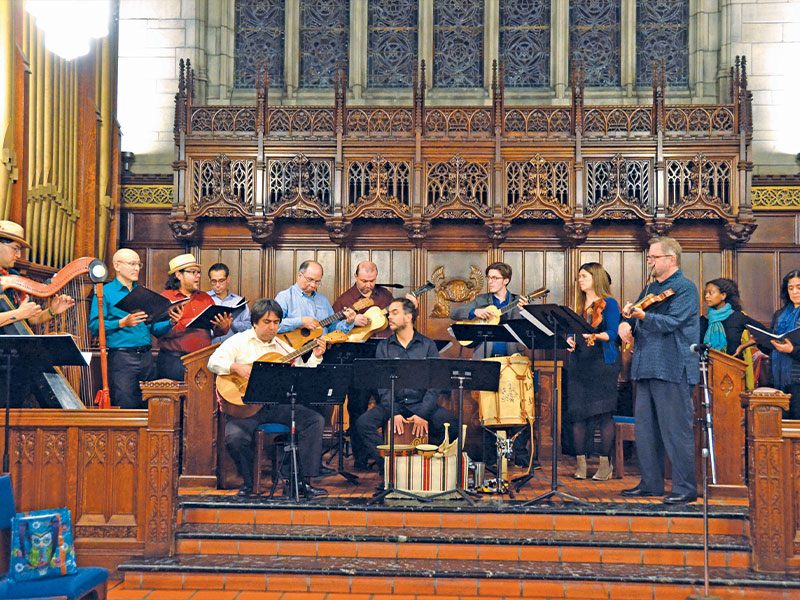A Mexican Christmas
The Newberry Consort | Ellen Hargis, David Douglass directors
EnsAmble Ad-Hoc | Francy Acosta, José Luis Posada directors
The Newberry Consort and EnsAmble Ad-Hoc present A MEXICAN CHRISTMAS, an album of 17th century traditional music for worship and celebration. The collection features pieces commonly heard in both liturgical service and in the streets, and evoke the solemnity and fanfare heard in Mexico City’s convents and plazas, with jubilant vocals and lively strings, guitars, and percussion. Organ, harp, bassoon, and a variety of Mexican traditional instruments bring this exuberant and diverse music to life.
Listen
Stream/Buy
Choose your platform
"The album is, in a word, fun"
Track Listing & Credits
| # | Title | Composer | Performer | |
|---|---|---|---|---|
| 01 | Introducción/Christus natus est nobis | Juan Gutiérrez De Padilla | Convent Ensemble: The Newberry Consort, Villancico Ensemble: EnsAmble Ad-Hoc | 5:04 |
| 02 | Voces, las de la capilla | Juan Gutiérrez De Padilla | Convent Ensemble: The Newberry Consort | 6:54 |
| 03 | Andrés ¿Do queda el ganado? (guineo) | Gaspar Fernández | Villancico Ensemble: EnsAmble Ad-Hoc | 3:44 |
| 04 | Qué música divina | José De Cáseda | Convent Ensemble: The Newberry Consort | 9:05 |
| 05 | Serenísima una noche | Fray Jerónimo Gonzalez | Convent Ensemble: The Newberry Consort, Villancico Ensemble: EnsAmble Ad-Hoc | 4:00 |
| 06 | Al establo más dichoso | Juan Gutiérrez De Padilla | Villancico Ensemble: EnsAmble Ad-Hoc | 8:37 |
| 07 | Suspended, Cielos, vuestro dulce canto | Joan Cererols Montserrat | Convent Ensemble: The Newberry Consort | 10:47 |
| 08 | Si al nacer o miniño | Juan Gutiérrez De Padilla | Convent Ensemble: The Newberry Consort, Villancico Ensemble: EnsAmble Ad-Hoc | 4:43 |
| 09 | Dame albriçias, mano Antón (negrito) | Gaspar Fernández | Convent Ensemble: The Newberry Consort, Villancico Ensemble: EnsAmble Ad-Hoc | 3:46 |
| 10 | Cumbé | Santiago De Murcia, arr. J. L. Posada | Villancico Ensemble: EnsAmble Ad-Hoc | 2:58 |
| 11 | La Azucena | Santiago De Murcia, arr. J. L. Posada | Villancico Ensemble: EnsAmble Ad-Hoc | 2:39 |
| 12 | Convidando está la noche | Juan García De Zéspedes | Convent Ensemble: The Newberry Consort, Villancico Ensemble: EnsAmble Ad-Hoc | 7:14 |
CONVENT ENSEMBLE: THE NEWBERRY CONSORT
Ellen Hargis soprano, director
Elena Mullins, soprano
Lucía Mier y Terán Romero, soprano
Margaret Carpenter Haigh, soprano
Salomé Sandoval McNutt, soprano
Allison Selby Cook, alto
Beverly Simmons, alto
Candace Smith, alto
Rachel Begley, bassoon
Frances Conover Fitch, organ
Katherine Shuldiner, viola da gamba
Claire Happel Ashe, harp
VILLANCICO ENSEMBLE: ENSAMBLE AD-HOC
Francy Acosta soprano, director
Carolina Gómez, soprano
Amaranta Flores-Gualtieri, soprano
Magaly Cordero, alto
Nythia Martinez, alto
Camilo Rasquin, baritone
José Luis Posada guitars, director
Raúl Fernández, jarana
Patricio Leija leona
Javier Saume, percussion
Zacbe Pichardo, harp
WITH GUEST ARTISTS
Brandi Berry, violin
David Douglass, violin
Matthew Dean, tenor
Brandon Acker, baroque guitar
Eric Miranda, bass
with Jade J. Maze Al establo mas dichoso
Recorded live Dec 8, 2019 at First United Methodist Church in Evanston IL Recording Engineer John Mccortney, Airwave Studios
Executive Producer Bob Lord
Executive A&R Sam Renshaw
A&R Director Brandon MacNeil
A&R Morgan Santos
General Manager of Audio & Sessions Jan Košulič
Production Director Levi Brown
Audio Director Lucas Paquette
VP, Design & Marketing Brett Picknell
Art Director Ryan Harrison
Design Edward A. Fleming
Publicity Patrick Niland, Sara Warner
Artist Information
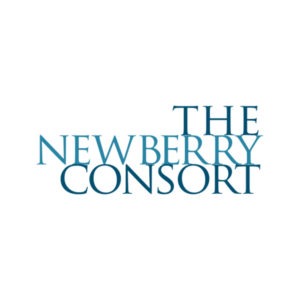
The Newberry Consort
The Newberry Consort presents historically-informed programs of early music—often drawn from the collections at the Newberry Library—through an annual concert series in Chicago, national and international touring, residencies at colleges and universities, and recordings. The Newberry Consort was founded in 1986 and has offered an annual concert series continuously since 1988. The ensemble incorporated as an independent nonprofit organization in 2009.
EnsAmble Ad-Hoc
EnsAmble Ad-Hoc was founded in Colombia by soprano Francy Acosta and lute & baroque guitar player José Luis Posada. Wanting to better approach the music they performed brought them to the United States, where they pursued graduate studies in early music. The core duet may invite ad hoc musicians, according to the demands of each program. The members of this ensemble are proud and excited to be collaborating with The Newberry Consort once again, as they bring to life musical jewels of Colonial Mexico.
Notes
The inspiration for this program came some years ago, when the Consort was on tour in Durango, Mexico. It was a national holiday, and, outdoors in the plaza in front of the church, traditional music was being performed by bands of musicians, electrically amplified to echo throughout the square. Everywhere we went in Durango that weekend we heard a soundscape of varied music: radios blaring pop songs, people singing and playing traditional music outdoors and in, organ solos filling the vast space of the Cathedral.
This reminded us of the descriptions of 17th-century Mexican convents, with people gathering outside the cloister walls to hear the nuns so renowned for their musical gifts, and villancico bands, groups of traditional musicians with folk instruments, playing at the gate of the convent to celebrate the entrance of a novitiate
about to leave the secular world to take the veil as a nun. For this, our second Mexican Christmas concert, we again recreate the contrasting grand solemnity in the cloister and festive atmosphere we imagine was enjoyed in the plaza outside the Convento de Nuestra Señora de la Encarnación in Mexico City.
